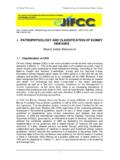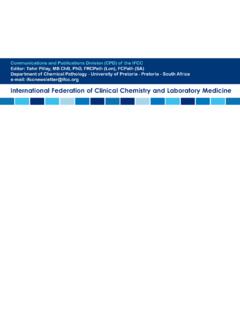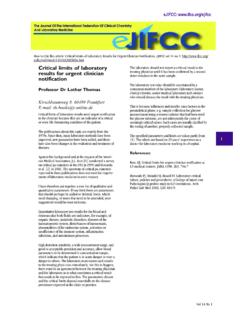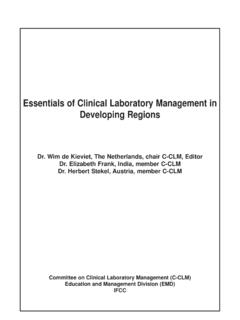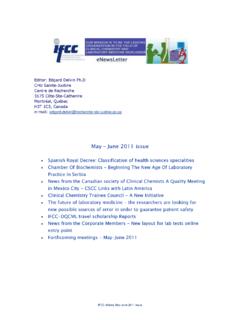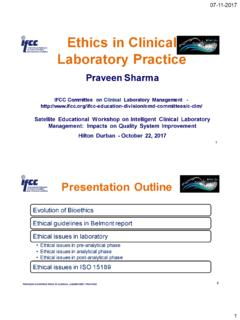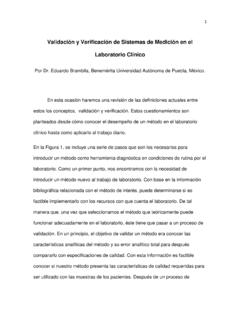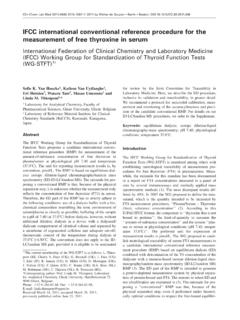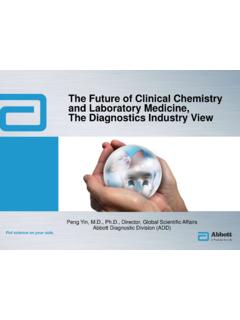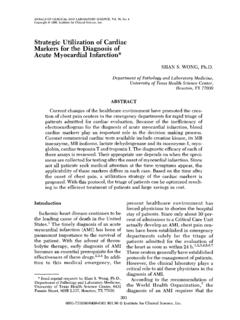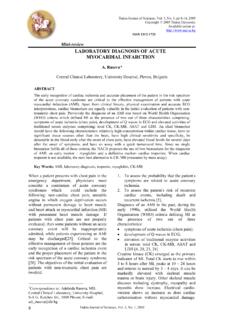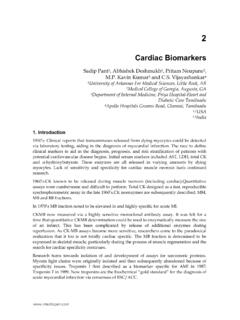Transcription of Biochemical markers of myocardial damage - IFCC
1 EJIFCC2016 Vol27No2pp095-111 Page 95In this issue: Celebrating the 70th Anniversary of the Hungarian Society of Laboratory Medicine Biochemical markers of myocardial damageGeza S. BodorDepartment of Pathology, University of Colorado, Denver, USAARTICLE INFOABSTRACTH eart diseases, especially coronary artery diseases (CAD), are the leading causes of morbidity and mor-tality in developed countries. Effective therapy is available to ensure patient survival and to prevent long term sequelae after an acute ischemic event caused by CAD, but appropriate therapy requires rapid and accurate diagnosis. Research into the pa-thology of CAD have demonstrated the usefulness of measuring concentrations of chemicals released from the injured cardiac muscle can aid the diagno-sis of diseases caused by myocardial ischemia. Since the mid-1950s successively better Biochemical mark-ers have been described in research publications and applied for the clinical diagnosis of acute ischemic myocardial injury.
2 Aspartate aminotransferase of the 1950s was replaced by other cytosolic enzymes such as lactate dehydrogenase, creatine kinase and their isoenzymes that exhibited better cardiac specificity. With the availability of immunoassays, other muscle proteins, that had no enzymatic activity, were also added to the diagnostic arsenal but their limited tis-sue specificity and sensitivity lead to suboptimal di-agnostic performance. After the discovery that car-diac troponins I and T have the desired specificity, they have replaced the cytosolic enzymes in the role Corresponding author:Geza S. Bodor, MD, DABCCP rofessor of Pathology Department of PathologyUniversity of Colorado, DenverAurora, CO 80045-0508E-mail: Veterans Administration Eastern Colorado Health Care System (VA ECHCS), DenverPathology and Laboratory Medicine Service 1131055 Clermont StreetDenver, CO 80220 USAP hone: +1-303-399-8020 x2625 Key words:coronary artery disease, myocardial infarction, Biochemical markers , cardiac markers , cardiac troponinseJIFCC2016 Vol27No2pp095-111 Page 96 Geza S.
3 BodorBiochemical markers of myocardial damageof diagnosing myocardial ischemia and infarc-tion. The use of the troponins provided new knowledge that led to revision and redefinition of ischemic myocardial injury as well as the in-troduction of biochemicals for estimation of the probability of future ischemic myocardial events. These markers , known as cardiac risk markers , evolved from the diagnostic markers such as CK-MB or troponins, but markers of in-flammation also belong to these groups of di-agnostic chemicals. This review article presents a brief summary of the most significant devel-opments in the field of Biochemical markers of cardiac injury and summarizes the most recent significant recommendations regarding the use of the cardiac markers in clinical practice. EPIDEMIOLOGY OF CORONARY ARTERY DISEASESH eart disease, along with malignancies, are the top two causes of death in developed coun-tries.
4 In the United States approximately 25 % of all deaths occur because of cardiac diseases. This is equivalent to 610,000 deaths each year from heart disease [1]. Sixty-one percent of the deaths, or 370,000 events, are due to coronary heart disease (CHD) [1] that is caused by choles-terol plaque buildup with consequent narrowing of the coronary arteries. This is known as coro-nary artery disease (CAD). When this plaque ruptures it activates the coagulation cascade lo-cally and the developing thrombus restricts or completely stops blood flow to the cardiac mus-cle downstream from the occlusion, causing the AACC: American Association for Clinical Chemistry, ACC: American College of Cardiology, ACS: acute coronary syndromes, AHA: American Heart Association, AMI: acute myocardial infarction, AST: aspartate transaminase, CAD: coronary artery disease, CABG: coronary artery bypass graft, CHD: coronary heart disease, CK: creatine kinase,CK-MB: creatine kinase MB isoenzyme, CRP: C-reactive protein, cTnI: cardiac troponin I, cTns: cardiac troponins, cTnT: cardiac troponin T, CV: coefficient of variation,ECG, EKG: electrocardiogram, ESC: European Society of Cardiology, HAMA: human anti-mouse antibody,hs: high-sensitivity, IFCC.
5 International Federation of Clinical Chemistry and Laboratory Medicine, IMA: ischemia modified albumin, LD, LDH: lactate dehydrogenase,LD-1: lactate dehydrogenase isoenzyme 1,LoD: limit of detection,MI: myocardial infarction, MoAb: monoclonal antibody,NACB: National Academy of Clinical Biochemistry, NQWMI: non-Q wave MI, NSTEMI: non-ST elevation MI, PCI: percutaneous coronary intervention, QWMI: Q-wave MI, SGOT serum glutamic oxaloacetic transaminase, STEMI: ST-elevation MI, TF-CB: Task Force on Clinical Applications of cardiac Bio- markers , TnI: troponin I, TnT: troponin T, UA: unstable angina, URL: upper reference limit, WHO: World Health OrganizationNon-standard abbreviations (in alphabetical order)eJIFCC2016 Vol27No2pp095-111 Page 97 Geza S. BodorBiochemical markers of myocardial damageclinical conditions known as angina and heart attack ( myocardial infarction). According to the 2013 US national statistics, the 370,000 deaths per year are the consequence of approximate-ly 735,000 heart attacks of which about one third (1/3) are recurrent events [1].
6 Based on population statistics it can be calculated that approximately 310 heart attacks per hundred-thousand people older than 18 years of age and approximately 150 deaths per hundred-thousand adults can be expected each year in developed nations. The number of people with heart disease and the death rate from CHD var-ies between sexes, racial groups and geographic region within a country and it increases with in-creasing age even within the same country, but CHD and heart attack are large public health is-sues and consume large amounts of health care dollars. As the severity of consequences of a heart attack increases with each minute of de-lay in diagnosis and treatment, early diagnosis is mandatory to minimize long term sequelae of an acute coronary HEART DISEASE AND ACUTE HEART ATTACKFor many people the first sign of having CHD is chest pain, caused by heart attack, but others may learn about their CHD from their doctor af-ter receiving results of laboratory tests as part of their annual check up.
7 Diet, smoking, pres-ence of diabetes, hypertension or hyperlipid-emia, among other things, can help estimate one s chance of having CHD or CAD, therefore measurement of blood pressure, cholesterol, blood sugar, body weight and body mass index as well as obtaining relevant medical history to collect information about one s diet, exer-cise and smoking habits can be the first steps of working up a patient for possible presence of CAD. If it appears that one is at high risk for CAD, additional tests can be performed using a variety of diagnostic procedures consisting of electrocardiogram (ECG or EKG), echocardio-gram, exercise test, cardiac catheterization and coronary angiogram. During an acute chest pain event the concentration of biochemicals can be measured in one s blood to asses if the person s CAD has progressed into a heart attack or if the chest pain is due to some other disease entity than coronary artery closure.
8 The laboratory markers used in the diagnosis and differential diagnosis of acute chest pain are collectively called cardiac markers , myocardial injury mark-ers or Biochemical markers of myocardial injury. This article will present a brief overview of the most significant cardiac markers and it will dis-cuss the use of those markers for the diagnosis of cardiac diseases but it will not talk in details about the non-laboratory diagnostic EARLY cardiac MARKERSThe first blood test to aid in the diagnosis of a heart attack was described in 1954 by Ladue, Wroblewski and Karmen in Science [2]. They found that the activity of the enzyme, serum glutamic oxaloacetic transaminase (SGOT), lat-er known as aspartate transaminase (AST), in-creased and remained elevated for several days following a heart attack. Because AST activity could be increased in other conditions than a heart attack search was started for other, better laboratory diagnostic markers of myocardial in-jury.
9 This search lead to the discovery of several other cytoplasmic enzymes that could also be used for the detection of a heart attack. Of the many candidates that were described in the lit-erature lactate dehydrogenase (LDH or LD) and creatine kinase (CK) gained wide clinical accep-tance. However, because these enzymes were also present in other tissues than the myocar-dium, their diagnostic specificity was limited especially in the presence of concurrent liver or skeletal muscle diseases or even strenuous exercise. Their diagnostic sensitivity also suf-fered from the presence of a sizeable baseline eJIFCC2016 Vol27No2pp095-111 Page 98 Geza S. BodorBiochemical markers of myocardial damageenzyme concentration in the circulation with-out any cardiac pathology, sometimes masking a small infarction because of the high back-ground . To overcome the sensitivity and speci-ficity limitations of LD and CK measurement, their more cardiac specific isoenzymes were in-troduced to clinical practice.
10 In the mid-1960 s it was discovered that the LD-1 isoenzyme of LD had better cardiac specificity than total LD ac-tivity and the LD-1 to LD-2 ratio was proposed to be a better diagnostic tool for the diagnosis of myocardial infarction (MI) than total enzyme activity measurement [3]. Unfortunately, LD-1 elevation could also be caused by minor in vivo or in vitro hemolysis [4]. LD-1 isoenzyme mea-surement was further limited because practical, relatively rapid analytical techniques could not be developed. Most laboratories were required to use gel electrophoresis for LD isoenzyme measurement although an immunoinhibition assay was later introduced to the medical mar-ket [5]. In spite of the many limitations of LD and LD-1 measurement it remained in clinical use until the troponin era because LD-1 con-centrations remained elevated for up to a week after an acute myocardial infarction (AMI) thus allowing diagnosis of a heart attack in patients who presented to the hospital after the other markers concentrations returned to normal.
